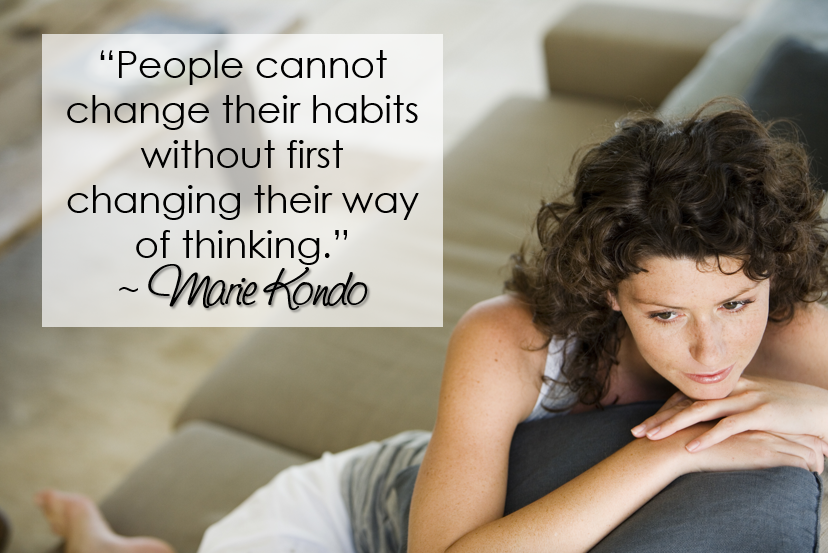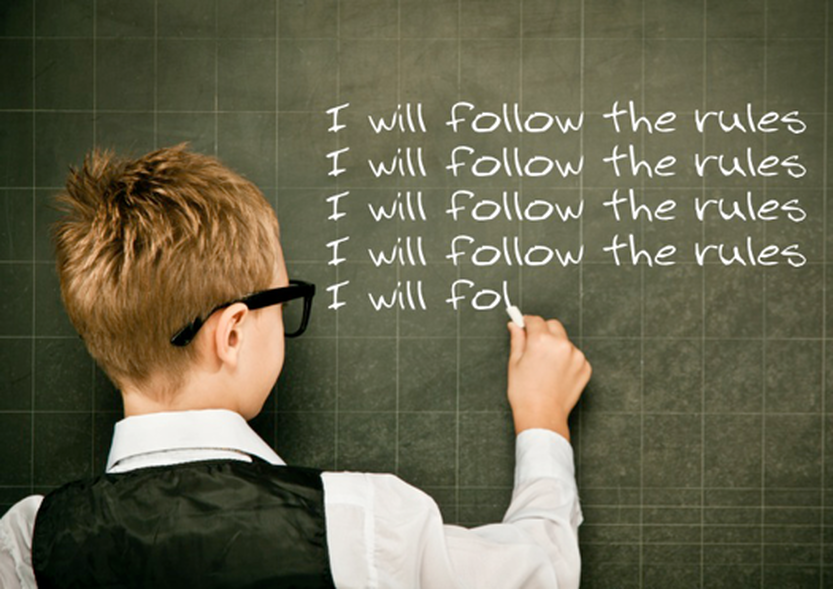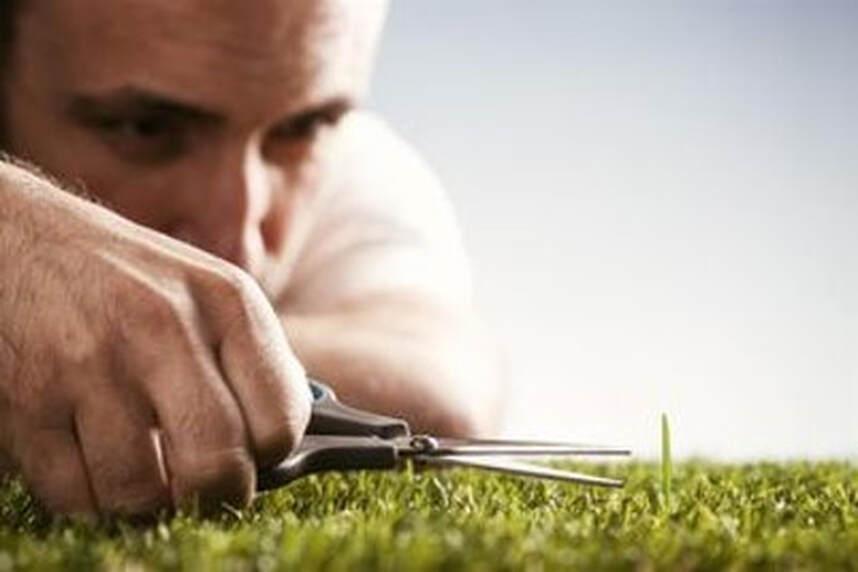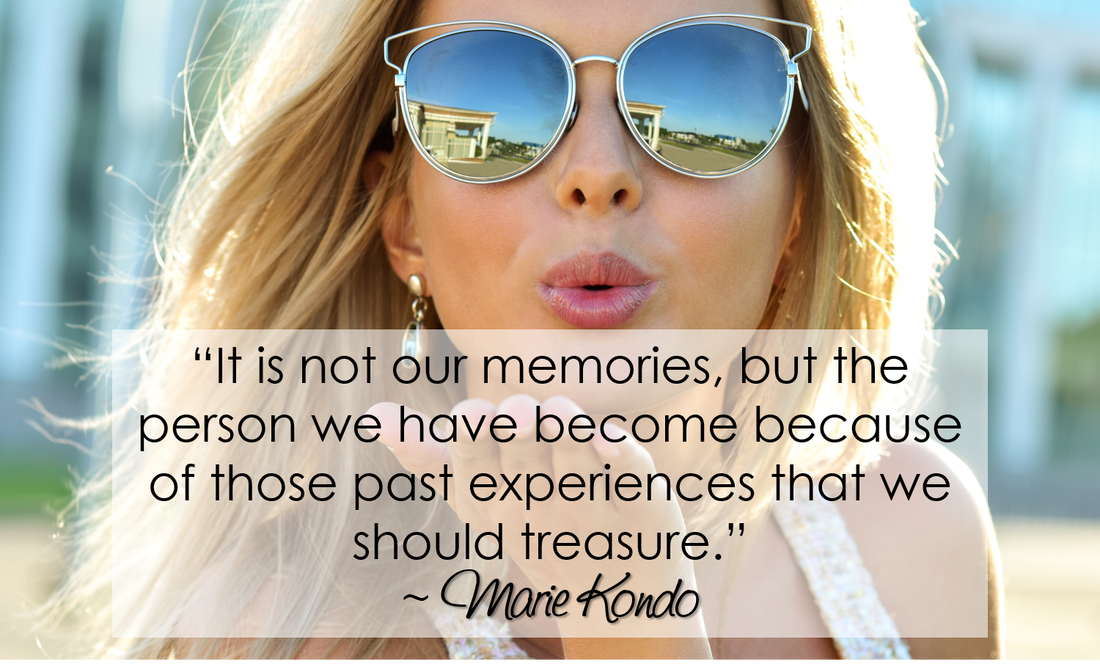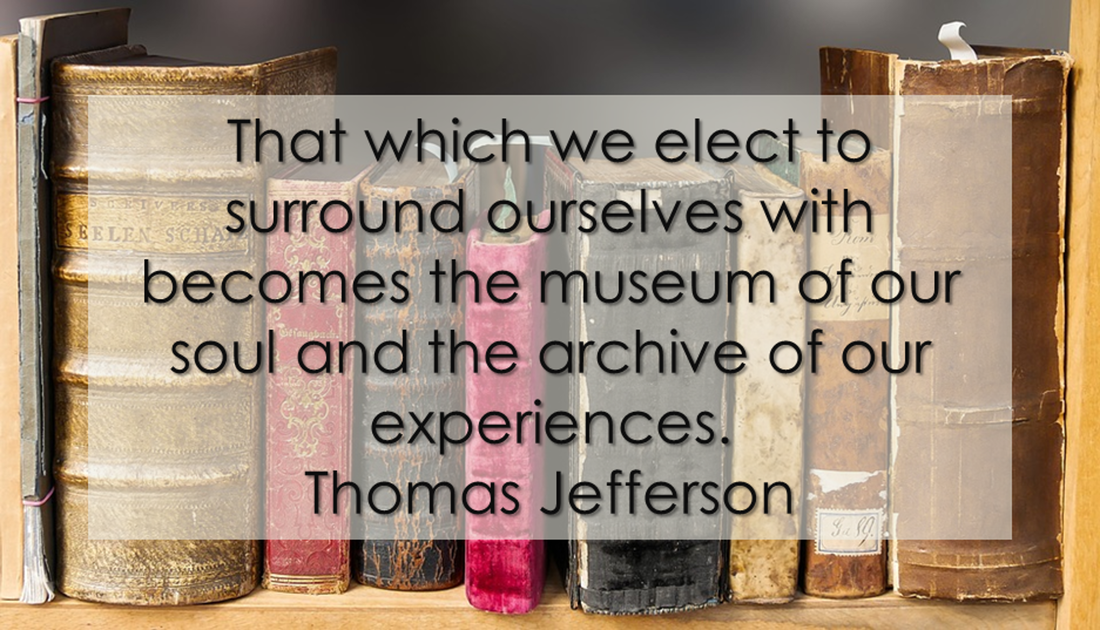|
|
Coming to Terms with Your Clutter Personality |
|
Merriam-Webster defines clutter (verb) in this way: "to fill or cover with scattered or disordered things that impede movement or reduce effectiveness".
I like this definition because it includes the phrases "impede movement" and "reduce effectiveness". That is exactly why clutter can be such a negative force in our lives. It gets in our way, both physically and mentally. It impacts our ability to focus, and it undermines our productivity.
Blogger Kelleigh Beckett (Imperfect Homemaking) defined clutter in this way:
I like this definition because it includes the phrases "impede movement" and "reduce effectiveness". That is exactly why clutter can be such a negative force in our lives. It gets in our way, both physically and mentally. It impacts our ability to focus, and it undermines our productivity.
Blogger Kelleigh Beckett (Imperfect Homemaking) defined clutter in this way:
|
Vertical Divider
|
"Clutter is the stuff that is keeping our homes from being what we need them to be. Clutter is too much and too many. Too many toys. Too many clothes. Too many things to do on a Saturday morning. Clutter complicates life without adding anything to it. Clutter is the meaningless getting in the way of the meaningful."
|
Vertical Divider
|
When looked at in this way, clutter can (and does!) include not only the physical items that surround us, but all the other aspects of our lives from overbooked schedules to toxic relationships.
We all have clutter, and we all hate clutter. So what on earth can we do about our clutter? To answer that question, let me share another quote. This one comes from blogger Chrissy Halton (Organise My House):
We all have clutter, and we all hate clutter. So what on earth can we do about our clutter? To answer that question, let me share another quote. This one comes from blogger Chrissy Halton (Organise My House):
|
Vertical Divider
|
"Both inside your home, and inside your head can get cluttered all too easily, and if we can’t identify the issue and deal with that, then the clutter will keep coming back no matter how much decluttering we do – decluttering is only the surface layer – you have to understand the underlying issues to make it a permanent change."
|
Vertical Divider
|
Identifying Your Underlying Issues |
|
Here is where clutter personalities come into play. Clutter personalities deal with the psychological reasoning that anchors us to our clutter. They are the excuses and wrong-thinking that enslaves us to our stuff, making it difficult to part with things that no longer have value in our lives. Identifying your clutter personality is the first step in overcoming the associated mental roadblocks that come with that particular way of thinking.
NOTE: It is possible (and even likely) to have multiple personalities when it comes to clutter, so don't be alarmed if you find yourself relating to more than one. Most people have multiple reasons for clinging to clutter, (although most of us tend to have one "personality type" that is more dominant than others).
NOTE: It is possible (and even likely) to have multiple personalities when it comes to clutter, so don't be alarmed if you find yourself relating to more than one. Most people have multiple reasons for clinging to clutter, (although most of us tend to have one "personality type" that is more dominant than others).
The Disabling Power of Decisions and Relationships |
|
Everything we own can be traced back to either our decisions or our relationships. Either we made a decision to bring an item into our life or someone gave us the item. Instead of letting those factors weigh us down, try thinking about it this way.
Understanding these truths can be helpful in learning to let things go without guilt.
- Decisions - When it comes to stuff that no longer meets our needs, it's OK to admit that some of our decisions were either bad to begin with or are no longer applicable to our lives. Getting rid of such items should be liberating rather than incriminating.
- Relationships - With regard to items we received from others, we need to understand that getting rid of something we have been given in no way reflects on our relationship with the giver, only on our relationship with the item.
Understanding these truths can be helpful in learning to let things go without guilt.
Identifying Your Clutter Personality |
|
Now let's examine some of the more common clutter personalities. Included with the description of each personality type are suggests for overcoming the mental roadblocks associated with that particular way of thinking.
THE PROCRASTINATOR
Type of Clutter: Clutter resulting from neglect or indecision
Type of Clutter: Clutter resulting from neglect or indecision
|
The procrastinator is a person who struggles with making decisions and acting on them. This person's home is cluttered with piles of stuff that was never really assigned a place within their space.. Other items lay about waiting to be returned to their designated space. In addition, procrastinators hold onto items that need to be returned to others and/or items that no longer work, not because they can't let them go, but because they can't make the decision or the time to get rid of them.
|
To overcome your inner Procrastinator:
- Make a plan - Outline a method for dealing with each type of clutter within your space. Tackle one type of clutter at a time, such as mail. Once complete, move onto the next clutter issue.
- Be decisive - Practice deciding where things go when they enter your home. Find a place for everything and put things back where they belong. If something doesn't work, get rid of that thing.
- Work in chunks - Give yourself specific, manageable tasks to complete and work on one simple task at a time.
- Eliminate distractions - Choose a time when you know you will be able to focus without interruption, and turn off electronic devices.
- Eliminate excuses - Identify what's preventing you from dealing with a particular clutter problem. Then set your excuses aside and do what needs to be done. Often the issues we imagine we'll encounter are far worse than the actual task we're avoiding.
THE PACK RAT
Type of Clutter: Clutter resulting from items that are not needed or used
Type of Clutter: Clutter resulting from items that are not needed or used
Pack rats tend to be focused on the future. They're constantly telling themselves that an item might be useful someday. They hold onto things that others consider junk such as empty containers. A favorite maxim of Pack Rats is "As soon as you get rid of it, you're going to need it".
To overcome your inner Pack Rat:
- Do a reality check - Ask yourself the hard question "Am I ever going to actually use this?", and then give an honest answer.
- Start with the easy stuff - Begin by decluttering things that have no sentimental or inherent value. This could include such things as recyclable items, expired items, items that are damaged, and so forth.
- Find your sticking point - Identify what it is that causes you to feel the need to hang onto items that you don't particularly need. This may require you to delve into the inner recesses of your soul and stir up some potentially unpleasant memories, but it is worth the discomfort to get beyond the issue and free yourself from the tyranny of clutter.
- Think of your family - When you are gone, someone will have to deal with all your stuff. Are you subjecting your loved ones to an unnecessarily overwhelming task? In her book, The Gentle Art of Swedish Death Cleaning (affiliate link), Margareta Magnussen says this: “Do not ever imagine that anyone will wish – or be able – to schedule time off to take care of what you didn’t bother to take care of yourself. No matter how much they love you, don’t leave this burden to them…A loved one wishes to inherit nice things from you. Not all things from you."
- Institute some rules - Rules can feel limiting, but establishing limits can actually have a liberating effect. Read more about this phenomenon in my blog post The Liberating Affects of Applying Constraints. In addition, here are a handful of basic organization rules that can help you set limits on the amount of clutter you keep.
RULES FOR PACK RATS
The Replacement Rule - When you buy a newer version of an item you already own, get rid of the older version.
Duplicate Rule - If you have multiples of the same item, choose your favorite and get rid of the excess. No one needs five vegetable peelers, or ice cream scoops, or... you get the idea.
Number Rule - If you have a problem with hoarding certain items, set a limit for yourself and stick to your limit. For instance, if you like to collect empty glass jars, limit yourself to a total of 10. When number 11 is emptied, and you're tempted to hang onto it, force yourself to sort through the others and pick one to get rid of so that your total never exceeds your personal limit.
Move/TIme Rule - If you're planning to move, and you come across items you haven't used since you moved into your current home (assuming more than a few months have elapsed), it's probably time to part with those things. If you don't have a move in your future, you can still apply this reasoning by selecting a time frame. For instance, if you haven't used an item in the past year or two, then it's no longer needed.
Equilibrium Rule - This is the one in-one out rule of decluttering. It works well with clothing, but it can apply to any number of things. When you purchase a new item, you find an unused item to get rid of so that your clutter equilibrium remains constant.
The Replacement Rule - When you buy a newer version of an item you already own, get rid of the older version.
Duplicate Rule - If you have multiples of the same item, choose your favorite and get rid of the excess. No one needs five vegetable peelers, or ice cream scoops, or... you get the idea.
Number Rule - If you have a problem with hoarding certain items, set a limit for yourself and stick to your limit. For instance, if you like to collect empty glass jars, limit yourself to a total of 10. When number 11 is emptied, and you're tempted to hang onto it, force yourself to sort through the others and pick one to get rid of so that your total never exceeds your personal limit.
Move/TIme Rule - If you're planning to move, and you come across items you haven't used since you moved into your current home (assuming more than a few months have elapsed), it's probably time to part with those things. If you don't have a move in your future, you can still apply this reasoning by selecting a time frame. For instance, if you haven't used an item in the past year or two, then it's no longer needed.
Equilibrium Rule - This is the one in-one out rule of decluttering. It works well with clothing, but it can apply to any number of things. When you purchase a new item, you find an unused item to get rid of so that your clutter equilibrium remains constant.
|
THE WORRIER
Type of clutter: Clutter resulting from guilt or fear. Worriers are often caught up in a cycle of self-imposed guilt. "I paid too much for that item, I can't just get rid of it." "My great aunt gave me that. It would hurt her feelings if I gave it away." That sort of thing. To a degree, most of us have a little bit of worrier in us. That said, the true worrier is overly concerned about what might happen to the point of being unable to see the negative impact that results from keeping unwanted items. |
To overcome your inner Worrier:
- Adjust your attitude
- Keep only those things that speak to your heart
- Trade fear and worry for freedom and clarity
Stuff is meant to serve a purpose. Once an item has fulfilled its purpose, it’s wise to let it go. Keeping such items can be burdensome both to our physical space and our emotional well-being. If you bought an item, and you didn’t use it, don't beat yourself up about it and hold onto the unwanted thing as penance. Think of it as a lesson learned and move on with your life. If someone gave you a gift you don't like, want, or need, don't waste precious space on its storage. Understand that the purpose of a gift is to express a sentiment. This purpose is accomplished in the giving and receiving of the gift. Beyond that the gift may serve no further purpose in your life. Give yourself permission to let go.
Consider this thought from Japanese organizer Marie Kondo:
|
Vertical Divider
|
“To truly cherish the things that are important to you, you must first discard those that have outlived their purpose. To get rid of what you no longer need is neither wasteful nor shameful. Can you truthfully say that you treasure something buried so deeply in a closet or drawer that you have forgotten its existence? If things had feelings, they would certainly not be happy. Free them from the prison to which you have relegated them. Help them leave that deserted isle to which you have exiled them. Let them go, with gratitude.”
|
Vertical Divider
|
THE DREAMER
Type of Clutter: Clutter resulting from unrealized aspirations.
Type of Clutter: Clutter resulting from unrealized aspirations.
Dreamers have big plans but little time. They've always got a new project or idea in mind. They make it far enough to gather the needed supplies to achieve their vision, but they seldom make it beyond this initial step. The reasons for their failure include lack of time, lack of energy, lack of interest, and more.
To overcome your inner Dreamer:
To overcome your inner Dreamer:
- Do a reality check - Ask yourself the hard question: "Am I ever going to complete this project?", and give yourself an honest answer.
- Pick a project, hobby, or goal - Start with one thing you want to achieve. Once you've succeeded, give yourself permission to move onto the next thing. Avoid buying supplies for a new project, if you haven't completed the last project.
- Have fun sharing the wealth - Brainstorm people or organizations who might have a legitimate use for your unused supplies and then present them with a gift. Be sure to check with people in advance to make sure they have a need for and interest in your items.
THE PERFECTIONIST
Type of Clutter: Clutter resulting from inaction due to unrealistic expectations.
Type of Clutter: Clutter resulting from inaction due to unrealistic expectations.
Perfectionists hold themselves to an unrealistic standard. They are unhappy accepting anything that falls short of the ideal. It seems strange in a way that perfectionists would have problems with clutter, since clutter definitely leads to a less than perfect environment, but the two are often closely linked. The reason seems to be that the unrealistic expectations of perfectionists can lead to a fear of failure which ultimately prevents them from acting.
Overcoming your inner Perfectionist:
Overcoming your inner Perfectionist:
- Learn to embrace the 80% solution -The idea here is that it is better work until you achieve 80% of what you set out to do than it is to not do anything because you can’t do 100%. You will never be able to declutter your home 100%. That is the nature of clutter. As soon as you clear some away, more moves in. To say it’s not worth dealing with it if you can’t get it all is defeatist and inaccurate.
- Be perfect in pieces - You may not be able to have a perfectly organized home, but you can have a nicely organized pantry, or bathroom, or dresser, or whatever feels most important to you.
- Focus on progress - Tell yourself this: better is good. So it's not perfect. It never will be. But that doesn't mean it can't be significantly improved, and any improvement will look and feel and function better.
- Focus on the big picture - Recognize that your home will always be a work in progress. Set a realistic organization goal and then strive for that goal a little at a time. Slowly but surely you can get there.
THE BARGAINNISTA
Type of Clutter: Clutter resulting from an over-zealousness for shopping and bargain hunting.
Type of Clutter: Clutter resulting from an over-zealousness for shopping and bargain hunting.
Bargainistas are so concerned with getting a bargain they often end up with things they don't need, can't use, and don't have room for. Some bargainistas don't even bother to take their purchases out of the shopping bags they came in. This is a true sign of a problem. They're so caught up in saving money, they spend unnecessarily in vane pursuit of a good deal.
Overcoming your inner Bargainista:
- Redefine bargain - Keep in mind that it is only a bargain if you save money on something you need. Money spent on items you don't need and aren't going to use is the opposite of a bargain. It's wasteful spending.
- Limit yourself - Make a budget, and stick to it.
- Avoid danger zones - If you're a sucker for fabric stores, avoid them. If you can't pass up a sale at your favorite clothing outlet, don't go there. Stay away from places where you know you can't resist the urge to spend.
- Implement the buddy system - Bring a friend or family member with you when you shop, and ask them to help you stick to your budget and avoid impulse buying.
- Practice the one in-one out rule - As discussed in association with Pack Rats, this rule dictates that when you bring a new item into your space, you select an unused item to get rid of.
THE SENTIMENTALIST
Type of Clutter: Clutter resulting from an inability to part with the past.
Sentimentalists are caught up in the past. They hold onto things because they have 'meaning'. The problem is, they can find meaning in almost anything. They have a fear that letting go of an item will somehow do away with the memory of the person or experience associated with that item.
Type of Clutter: Clutter resulting from an inability to part with the past.
Sentimentalists are caught up in the past. They hold onto things because they have 'meaning'. The problem is, they can find meaning in almost anything. They have a fear that letting go of an item will somehow do away with the memory of the person or experience associated with that item.
Overcoming your inner Sentimentalist:
- Determine what's really important to you - What’s important is your present and the people in it as well as your emotional, mental, and physical well-being. To determine what's really important to you, you'll need to think about what you want your life and your space to look like and then choose those items that fit with your vision. I talk more about this notion in my blog post The Power of Positive Purging.
- Repurpose mementos - When we allow keepsakes to overrun our space, we let the past dictate the present. It’s a good practice to sort through keepsakes every twelve months and weed out the ones that have lost some of their charm, either because the item itself has deteriorated or because our fondness for it has diminished. Bring the things you truly love out into the light of day – create quilts, pillows, scrapbooks, calendars, wall art, shelving, etc.
- Learn ways to let go - Keep in mind that objects don’t contain memories. Our memories are forever a part of us. If there is something you want to remember (but not keep), take a photograph and create a scrapbook page to honor the memory associated with that thing.
- Focus on what you will gain, not on what you are giving up - The benefits of decluttering are too numerous to list here (and are highlighted in various other places on the website). The important thing is to realize that this is a trade off. You're getting rid of something, but you're gaining a good deal in exchange to include additional space, peace of mind, and a more functional, attractive environment.
Coming to Terms with Your Clutter Personality |
|
Once you understand the underlying reasons for the clutter in your life, you are better equipped to combat that clutter. Armed with this knowledge, you can devise strategies for overcoming those ingrained tendencies and develop new attitudes regarding your relationship with your stuff. The ultimate goal of decluttering is to create a space in which you are surrounded by things that speak to your soul, a space in which you feel at peace. When the decluttering is done, what remains should be those things that are most meaningful to you.
I'd like to end with one last favorite quote. This one comes from Thomas Jefferson.
I'd like to end with one last favorite quote. This one comes from Thomas Jefferson.
When I walk into my home, I want to feel like I am home – in the one unique space on the planet that reflects who I am and what matters to me and my family. I know you want that for your space as well. So the question for all of us is:
What story is my stuff telling about me?
Is it the story I want to tell?
What story is my stuff telling about me?
Is it the story I want to tell?
Proudly powered by Weebly

